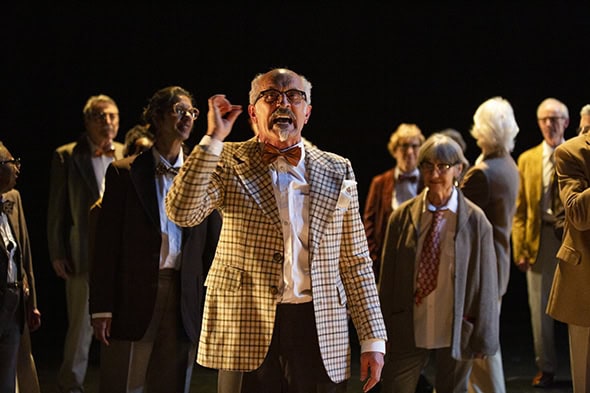Elixir Extracts Festival at Sadler’s Wells
Posted: July 9th, 2019 | Author: Nicholas Minns & Caterina Albano | Filed under: Festival, Performance | Tags: Alesandra Seutin, Clara Andermatt, Company of Elders, Donald Hutera, DOPODO, Elixir Extracts, Elixir Festival, Jennifer Hale, Liz Aggiss, Men! Dancing!, Merseyside Dance Initiative, Monica Tuck, PC*DC | Comments Off on Elixir Extracts Festival at Sadler’s WellsElixir Extracts Festival, Lilian Baylis Theatre, June 14-16

Billed five years ago as a lifelong celebration of creativity, Elixir Festival focused on mature dancers, both professional and amateur, to counter the notion of ageism in a predominantly youthful dance culture. The format consisted of a mainstage mixed bill with professional and ex-professional dancers like Mats Ek, Ana Laguna, Dominic Mercy, as well as members of the original London Contemporary Dance Company, while the smaller Lilian Baylis theatre hosted two days of performances by amateur groups. The mix was inspiring if uneven — professionals who have danced for over 40 years at the summit of their field have a mastery of dance language that amateurs, however dedicated, rarely can. Two years later the next incarnation of Elixir followed the original format but the balance had changed; the mainstage show failed to duplicate the excellence of the first iteration while some of the ‘extracts’ next door were markedly more interesting choreographically and expressively. Despite Sadler’s Wells being a signatory to a European co-operation project that addresses ageism in dance (Dance On, Pass On, Dream On, or DOPODO), this year’s Elixir Extracts Festival — even the name suggests something is missing — retreats so far from its original idea that the distinction between professional and amateur has disappeared altogether and ageism in the dance profession has dropped off the radar; Elixir has become a yellow pages of over-sixties community dance in the UK.
The quality of works on the program tends to suffer not so much from any low ability among the dancers but of choreography that fails to challenge their age. The one exception on Saturday was Dance Six-O’s performance of Liz Agiss’s Head In My Bag which, in Agiss’s inimitable language, ‘dumps age centre stage and kicks preconceptions into the long grass.’ Because Agiss is herself a performer of a certain age (though she has not been invited to previous Elixir festivals) she knows how to lift performance to a level that goes well beyond the demonstration of community and health benefits; she has an artistic vision that has no truck with the limitations of age. Her performers, with handbags on their heads, become a radical army of spirited individuals calling for the overturn of institutional myopia.
Sunday’s program kicks back with a little more force, particularly from the Merseyside Dance Initiative’s Men! Dancing! performing Shoulder to Shoulder choreographed by MDI’s Jennifer Hale, and the PC*DC’s infectious finale, Your Invisible Balls Please. In the former, six men distil tension, aggression and resistance into a convincing choreographic form of mutual support, while the latter is a riotous refusal to go quietly led by the irrepressible Donald Hutera. It’s an apt message on which to close Elixir Extracts: in opting for the social value of older amateur dance over the artistic significance of mature dance, Sadler’s Wells is not so much challenging ageism in dance as avoiding the issue altogether.
In contrast to the two programs of extracts that are limited to around ten minutes each, Sadler’s Wells’ own flagship elderly amateur group, Company of Elders, celebrates 30 years of activity with a full-length evening of dance. With ages ranging from 60 to 90, the company can hardly be accused of ageism, but while its longevity supports the argument for older amateur dance, the range of its members’ abilities requires an approach to choreography that resolves the inherent limitations of its repertoire.
Alesandra Seutin’s Dare I Speak bypasses this opportunity by proposing the final speech and subsequent disappearance of the Congo’s first prime minister, Patrice Lumumba, as subject. In wrapping the company in a narrative that is beyond the embodied experience of its performers, Seutin turns gestures of menace and violence into expressions of half-hearted complicity. The context of African dances emphasizes the ability of Monica Tuck but while this is a benefit for the audience it does little to carry the momentous events Seutin proposes; it’s a fine subject on the wrong company.
Clara Andermatt’s Natural 2019 approaches the company from within. It’s a reconstruction of a work Andermatt created on Company of Elders in 2005; fourteen years later seven members are still involved. It is ‘natural’ in the way it presents each person and transforms their experiences into dance theatre but while its confessional nature suits the company, the disparate abilities of its members limit the development of its choreographic form. If the artistic potential of the company is to develop in line with its flagship, repertoire status, ageism may prove to have a time limit.